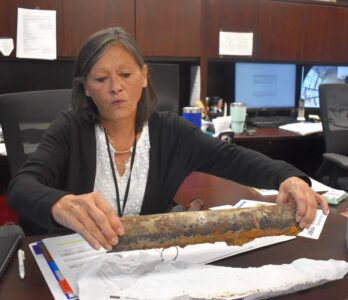MNDOC hosts informative meeting on predatory offenders
FAIRMONT – With a Level 3 Predatory Offender entering Fairmont, the Minnesota Department of Corrections gave information during a public meeting in Fairmont on Wednesday on the offender and what people should keep in mind.
Terry Schulz was convicted March 30, 2020, on three counts of Second Degree Criminal Sexual Conduct with a victim under 13 from 2014, 2019, and multiple incidents between 2014 and 2019. These charges carried stays of 65, 48, and 36 months, respectively, with 2/3rds to be served in prison and 1/3rd to be served outside on supervised release.
Level 3 means a higher risk of reoffending. It requires broad public notification, notification of victims and witnesses to crimes, other law enforcement agencies and individuals and entities that could be at risk based on known conduct and behavior of the offender.
Currently, he is on intensive supervised release in Ward 4 Precinct 1, which includes four face-to-face contacts weekly at random times, electronic home and GPS monitoring, daily curfews, mandatory restitution and random drug testing.
While in prison, three more cases were uncovered with victims under the age of 13, which occurred in 1999, 2000 and 2012. With court consolidation, he got two convictions of 45 months and 59 months, with 2/3rds to be served inside and 1/3rd served outside on supervised release. He was just released into Fairmont on September 29.
Under all of these five charges, MNDOC Notification Coordinator Brad VanderVegt said Schulz’s MO has been taking advantage of developed and trusting relationships with victims and sometimes adult support people of victims.
With two of his five charges, he has been given a lifetime of supervised release and a lifetime of registration on the predatory offenders registry.
Unlike other states and what’s popularized on TV, VanderVegt said Minnesota does not have a parole system where offenders argue their case for parole release in front of a board.
“What we found from our data and research was that that model did not impact reoffending in an effective way,” he said. “What was happening was these guys would sit in languish for the duration of their prison sentence. We ended up having guys walk to the gates of the institution and told by the corrections officers in the sternest of ways, ‘Don’t come back.’ It did not impact recidivism the way we knew we had to.”
Instead, they have determinate sentencing, where durations of sentences are set by law through a sentencing commission. While serving 1/3rd of each sentence in the community means less time in prison, VanderVegt said it creates a transitional period.
“The work they’ve been doing for treatment, programming, medication, whatever they’re working on, gets brought out into the community under the very attentive oversight of their supervised release agent,” he said. “This agent will then take the work they’ve done and translate that into the community, so they continue to internalize those methods and programming tools to continue to mitigate risk.”
One of the most common questions VanderVegt said he receives from people is where an offender lives specifically. While he knows that information will get out into the community at some point, VanderVegt cautioned against spreading that information or exacting any type of vigilante action.
“That does nothing to restore a victim and does nothing to protect [against] future harm,” he said. “What it does do is disrupt the very thing you work so hard to achieve here in your community. It puts notification at risk. For every registrant that gets beaten, for every house that gets burnt to the ground, the arguments against notification start to compel the courts to say that the benefits of notification no longer outweigh the consequences.”
Over levels 1, 2 and 3, 71 registered predatory offenders live in the Fairmont Zip Code, and 110 live in Martin County. VanderVegt wrapped up his information by saying if people see anyone engaging in behavior or conduct they feel is not safe or okay, they call 911.
“I want you to get comfortable with it,” he said. “If you see something that just ‘This seems weird,’ or ‘This car keeps circling this group of kids,’ or ‘There’s this guy that’s always out whenever the kids are out walking.’ I want you calling these guys, because they have resources and tools available to them the rest of us don’t. They can check around and make contact, maybe it’s someone we want to know more about.”
For more information and to find resources, visit mn.gov/doc/community-supervision/community-notification/.

